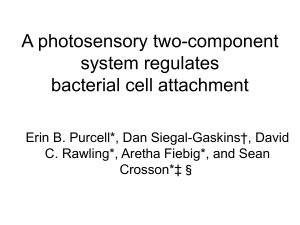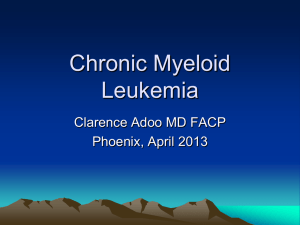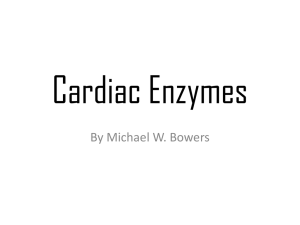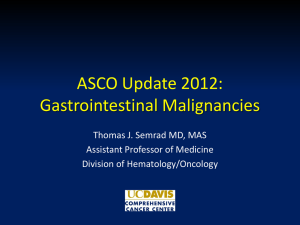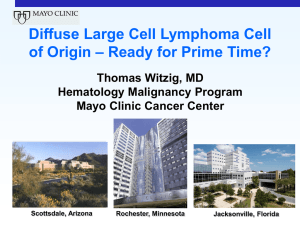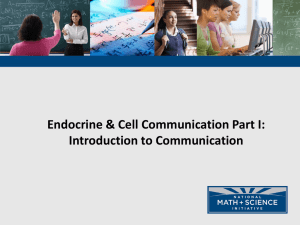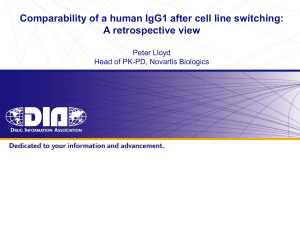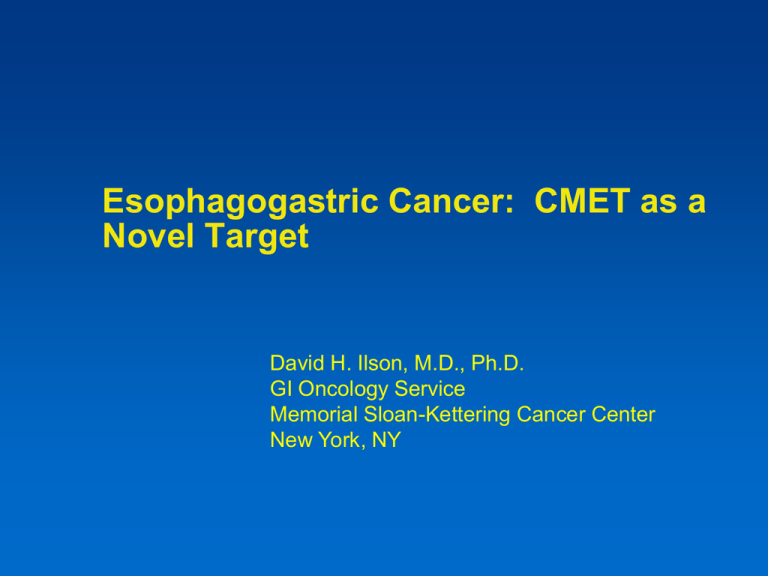
Esophagogastric Cancer: CMET as a
Novel Target
David H. Ilson, M.D., Ph.D.
GI Oncology Service
Memorial Sloan-Kettering Cancer Center
New York, NY
DISCLOSURES
Grant/Research Support
– Amgen
– Bayer
– Bristol-Myers Squibb
Consultant
– Amgen
– Lilly
– Imclone
Speaker’s Bureau
– Genentech
Esophageal and Gastric Carcinoma
US Incidence in 2014
40,390 new cases
– Gastric: 22,220 (55%)
– Esophagus: 18,170 (45%)
Male > Female
Decline in Gastric Cancer Incidence
Increase in Esophageal , GE JX, cardia adeno
OS improvement, 1975-77, 1984-86, 1999-2006
– Gastric: 16% 18% 27%
– Esophageal: 5% 10% 19%
Siegel et al, CA 64: 9-29; 2014
Advanced Esophagogastric Cancer
Chemotherapy: What Regimen to Use?
Oxali:
Cape:
EOX or
EOF
ECX or
EOX
XP
FLO
Pts
489
513
160
%RR
44%
45%
TTP,
months
6.7
OS,
months
10.9
FUFIRI
S-1
Cis
DCF
ECF
109
170
305
221
126
41%
34%
32%
54%
36%
45%
6.5
5.6
5.5
5.0
6.0
5.6
7.4
10.4
10.5
10.7
9.0
13.0
9.2
8.9
Cunningham NEJM 358:36;2008, Kang Annals Oncol 20:666;2009, Al-Batran JCO 26:1435;2008, Dank Annals Oncol
19:450;2008 Koizumi Lancet Oncol 9:215;2008, Van Cutsem JCO 24:4991;2006, Webb JCO 15:61;1997
Patient Selection for Chemotherapy
3 drug regimens (DCF, mDCF)
– High functional status, younger patients without
comorbidities
– Willingness to tolerate side effects
– Access to frequent follow up and toxicity
assessment
ECF: does epirubicin add anything but
toxicity?
Does Epirubicin add benefit to Platinum/5-FU
Chemo?
CALGB 80403 / ECOG 1206:
Randomized Phase II Study of Standard
Chemotherapy + Cetuximab for
Metastatic Esophageal Cancer
PC Enzinger, BA Burtness, DR Hollis,
D Niedzwiecki, DH Ilson, AB Benson 3rd,
RJ Mayer, RM Goldberg
CALGB 80403 / ECOG E1206: ECF vs
FOLFOX
ARM A: (ECF + cetuximab); 1 cycle = 21 days
Cetuximab 400 250mg/m2 IV, weekly
Epirubicin 50 mg/m2 IV, day 1
Cisplatin 60mg/m2 IV, day 1
Fluorouracil 200mg/m2/day, days 1-21
Stratification:
ECOG 0-1 vs 2
ADC vs. SCC
ARM B: (IC + cetuximab); 1 cycle = 21 days
Cetuximab 400 250mg/m2 IV, weekly
Cisplatin 30 mg/m2 IV, days 1 and 8
Irinotecan 65 mg/m2 IV, days 1 and 8
ARM C: (FOLFOX + cetuximab); 1 cycle = 14 days
Cetuximab 400 250mg/m2 IV, weekly
Oxaliplatin 85 mg/m2 IV, day 1
Leucovorin 400 mg/m2, day 1
Fluorouracil 400 mg/m2 IV bolus, day 1
Fluorouracil 2400 mg/m2 IV over 46hrs (days 1-2)
CALGB 80403/ECOG 1206: Phase II FOLFOX vs ECF vs
Irino/Cis, + Cetuximab
ECF-C
N=64
IC-C
N=68
FOLFOX-C
N=69
0
37
(58%)
15
(23%)
4
( 6%)
5 / 3 (8% /5%)
1
( 1%)
30
(44%)
23
(34%)
10
(15%)
2 / 2 (3% /3%)
2
( 3%)
35
(51%)
19
(28%)
8
(12%)
3 / 2 (4% /3%)
45.6
45.6
35.2
56.3
<.0001
53.6
53.6
43.1
64.0
<.0001
Response
CR
PR
SD
PD
Not eval / unknown
Objective Response Rate*
(CR+PR)/total
(90% C.I.)
CI)
(90%
P vs
p
vs.HH0≤0.25
0<0.25
57.8
57.8
46.8
68.3
<.0001
Response duration (mos)
median
range
6.1
0.5 - 22.7
5.3
5.3
0.5 - 20.1
5.7
5.7
2.4 - 18.2
*RECIST - confirmed; restaging every 6 weeks
CI, confidence interval; CR, complete response; PD, progressive disease; SD, stable disease
Enzinger PC, et al. J Clin Oncol. 2010;28 (15S): Abstract 4006.
CALGB 80403/ECOG 1206: Survival
ECF-C
N = 67
IC-C
N = 71
FOLFOX-C
N = 72
Total
N = 210
Mos
95% CI
Mos
95% CI
Mos
95% CI
Mos
95% CI
11.5
51
(8.1, 12.5)
8.9
52
(6.2, 13.1)
12.4
51
(8.8, 13.9)
11.0
154
(8.8,
12.3)
PFS Median
# dead/pd
5.9
57
(4.5, 8.3)
5.0
64
(3.9, 6.0)
6.7
63
(5.5, 7.4)
5.8
184
(5.1, 6.8)
TTF Median
# dead/pd/
off for AE
5.5
(3.9, 7.2)
4.5
(3.6, 5.6)
6.7
(4.8, 7.2)
5.5
(4.5, 5.9)
OS
Median
# dead
58
66
64
188
FOLFOX = ECF
AE, adverse event; PFS, progression-free survival; TTF, time to treatment failure
Enzinger PC, et al. J Clin Oncol. 2010;28 (15S): Abstract 4006.
Second Line Chemo Gastric Cancer Phase III
Trials Improved Survival
Docetaxel
vs
BSC
Docetaxel
or
Irinotecan
vs
BSC
Paclitaxel
vs
Irinotecan
Patients
84
84
133
69
111
112
RR %
7%
--
13%
17%/10%
--
21%
14%
PFS
12.2 wks
NS
NS
NS
3.6 mo
2.3 mo
OS
5.2 mo
3.6 mo
5.3 mo
(5.2-6.5)
3.8 mo
9.5 mo
8.4 mo
Significance
HR 0.67
P = 0.01
HR 0.657
P = 0.007
Ford H Lancet Oncol 15:78; 2014; Kang JH J Clin Oncol 30:1513; 2012 Ueda JCO 31: 4438;
2013
Gastric Cancer Second Line Chemo vs
BSC: Survival
Docetaxel/Irinotecan vs BSC
Docetaxel vs BSC
The hallmarks of cancer:
Emerging hallmarks
Evading growth
growth
Evading
suppressors
suppressors
Resisting
cell death
Resisting
cell death
The Hallmarks
of Cancer
Sustaining
proliferative
Sustaining
signaling
proliferative
signaling
Enabling
Enabling
replicative
replicative
immortality
immortality
Inducing
Inducing
angiogenesis
angiogenesis
Activating
invasion
and metastasis
Adapted from Cell, 144, Hanahan D, Weinberg RA, The hallmarks of cancer: the next generation,
646-674, copyright © 2011, with permission from Elsevier.
2009 Genentech USA, Inc. MBoC Program
Gene Amplification more common in
Esophagogastric Cancer
296 Esophageal / Gastric
Cancers, 190 CRC
Amplified genes in 37% Gas /
Eso tumors
– FGFR1-2
– HER2
– EGFR
– MET
Targetable Receptors and
Receptor Tyrosine Kinases
KRAS also amplified
Similar data for a Chinese
series
Dulak AM et al Can Res 72: 4383; 2012
Gastric Cancer Genomic Analysis:
Singapore
193 primaries, 40 cell lines
Common gene amplifications in
5 categories
KRAS: 9%
FGFR2: 9%
EGFR: 8%
ERBB2: 7%
MET: 4%
– Receptor Tyrosine Kinase
pathways commonly affected
– All upstream from KRAS
– 37% targetable by RTK/Ras
directed therapy
Deng et al Gut 61: 673; 2012
Molecular Targets:
Esophageal and Gastric Cancer
• Except for trastuzumab, there is no
identified molecular target in gastric
cancer
• Except for HER2, there is no identified
biomarker for gastric cancer
• Recent Trials of EGFr, VEGFr Targeted
Agents
– Largely Failed
– Unselected patient population
VEGF Revisited?
• Ramucirumab: Humanized moAb
Targeting VEGr2 receptor
• REGARD: BSC vs Ramucirumab
• RAINBOW: 2nd Line Paclitaxel + / Ramucirumab
Fuchs CS, et al. Lancet. 2014;383(9911):31-39. Wilke GI Symposium 2014 LBA 7
CMET Pathway
Goyal L, et al. Clin Cancer Res. 2013;19(9):2310-2318.
CMET Receptor Structure
CMET Downstream Signaling
Blumenschein JCO 30:3287;2012
CMET Downstream Signaling
Tyrosine kinase signaling results in a multitude
of cellular effects: HER2-3 vs CMET
HER2
HER3
Met
RAS Sos Grb2 Shc
PI3K
PI3K
GAB1
AKT
PDK1
RAF
Grb2
GSK3b
MEK
NFκB
mTOR
MAPK
Cyclin D1
BAD
p27
NFκB
↓Apoptosis
Cell cycle
control
Angiogenesis
↑Survival
Proliferation
HER2=human epidermal growth factor receptor-2; HER3=human epidermal growth factor receptor-3; PI3K=phosphatidylinositol 3-kinase; GAB1=Grb2-associated binding protein 1; Grb2=growth factor receptorbound protein 2; STAT3=signal transducer and activator of transcription 3; RAS=rat sarcoma; Sos=son of sevenless; PDK1=phosphoinositide-dependent kinase-1; PTEN=phosphatase and tensin homolog;
RAF=rapidly accelerating fibrosarcoma; MEK=mitogen-activated protein kinase kinase; MAPK=mitogen-activated protein kinase; mTOR=mammalian target of rapamycin; BAD=Bcl-2–associated death promoter;
NFκB=nuclear factor kappa–light-chain enhancer of activated B cells; GSK3β=glycogen synthase kinase 3 beta.
Olayioye MA, et al. EMBO J. 2000;19:3159-3167. Rowinsky EK. Oncologist. 2003;8(3):5-17. Trusolino L, et al.
2012 Genentech USA, Inc. All rights reserved.
Nat Rev Mol Cell Biol. 2010;11:834-848.
22
CMET Prognostic in Esophageal Adeno
145 consecutive patients undergoing surgery
CMET high (54%)by IHC had poorer OS, DSS
Higher rates of local and metastatic recurrence
Higher CMET in higher T stage, N+, poorly differentiated
tumors
Independent Prognostic Factor, RR 2.3
Tuynman et al BJC 98: 1102; 2008
CMET
Gene amplification is relatively rare (5%)
– Rarer are activating TKI and other mutations
Over expression at the protein level is more
common (IHC)
– Overcrowding of the cell surface with receptors
engenders independence of ligand: constitutive
activation
CMET activation: cell survival, proliferation,
angiogenesis, and invasion and metastasis
– Protease activation and increase cell motility
– CMET and HGF signaling in vascular endothelium
promote angiogenesis
– Hypoxia promotes HGF production and upregulates
CMET expression
CMET
CMET amplified or over expressing
tumors appear more aggressive with
worse prognosis but appear more
sensitive to CMET targeted agents
Paracrine, autocrine activation: Ligand
Hepatocyte Growth Factor Receptor
dimerization Activation of receptor
associated tyrosine kinase
Downstream: PIK3CA Kinase, RAS,
STAT, RAC
CMET Receptor Cross Talk
Interaction with CMET with other receptors and intra
cellular Tyrosine Kinases
Surface Integrin proteins
– MET down regulates surface e-Cadherin (tumor
suppressor) which increases TCF/Beta catenin nuclear
signaling, increases proliferation
HER1 (EGFR): activates CMET by generation of reactive
oxygen species
HER2: Trastuzumab may upregulate CMET, interacts
with HER3
RON: shares homology with MET, and the ligand
Macrophage Stimulating protein shares homology with
HGF
How can we inhibit MET?
Targeting HGF ligand, preventing receptor
binding
Blockade of ligand binding to the CMET
receptor
Inhibition of C-MET receptor trans
phosphoyrlation and activation
Inhibition of activated kinase activity and
phosphorylation of the signal transducer
docking site
Interference with the docking site and signal
transducers
Prominent cMET / HGF Inhibitors
Agent
Structure
Target
Rilotumumab
Human monoclonal
antibody
HGF
Onartuzumab
Humanized monovalent c-MET
antibody
Tivantinib
(ARQ 197)
Small molecule
c-MET kinase
Cabozantinib
(XL184)
Small molecule
c-MET kinase
Other CMET Agents in Development
Rilotumumab
Humanized monoclonal antibody against HGF
Binds to the HGF ligand light chain
Inhibits binding of HGF to the CMET receptor
AE’s specific to rilotumumab include nausea,
fatigue, constipation, and peripheral edema
Toxicities in phase II + ECF, at 7.5 and 15
mg/kg dosing
– Peripheral edema, greater hematologic toxicity, more
thromboembolic events
CMET: Rilotumumab: Anti HGF Ligand
Antibody, First Line
Phase II
R
A
N
D
O
M
I
Z
E
Stratification factors:
ECOG PS 0 vs 1
LA vs Metastatic
ARM A
Rilotumumab (15 mg/kg) + ECX
Q3W (n = 40)
ARM B
Rilotumumab (7.5 mg/kg) + ECX
Q3W (n = 40)
ARM C
Placebo + ECX
Q3W (n = 40)
E: Epirubicin: 50 mg/m2 IV, day 1
C: Cisplatin: 60 mg/m2 IV, day 1
X: Capecitabine: 625 mg/m2 BID orally, days 1-2
Rilotumumab: IV over 60 ± 10 minutes prior to chemotherapy
ClinicalTrials.gov identifier: NCT00719550
Zhu M, et al. J Clin Oncol. 2012;30(Suppl): Abstract 2535.
Analysis of c-Met Expression by IHCa
Patientsb, n
Acceptable tumor sample available, n (%)
c-Met assay failed, n
118
90 (76)
0
c-MetHigh, n (%)
38 (42)
c-MetLow, n (%)
52 (58)
Evaluable patients in treatment arms
a
b
Arms A + B: All rilotumumab + ECX, n (%)
62 (78)
Arm C: Placebo + ECX, n (%)
28 (74)
c-MetHigh defined as >50% of tumor cells express c-Met
Per protocol analysis set
Zhu M, et al. J Clin Oncol. 2012;30(Suppl): Abstract 2535.
PFS and OS in c-MetHigh Patients
Median Months
(80% CI)
HR (80% CI)
6.9 (5.1, 7.5)
0.53 (0.25, 1.13)
4.6 (3.7, 5.2)
Median Months
(80% CI)
HR (80% CI)
11.1 (9.2, 13.3)
0.29 (0.11, 0.76)
5.7 (4.5, 10.4)
Zhu M, et al. J Clin Oncol. 2012;30(Suppl): Abstract 2535.
Ongoing Trials: Met Inhibitors
Targeting CMET, + IHC
RILOMET-1: Phase III
– ECX + / - Rilotumumab (targeting ligand HGF)
MetGastric: Phase III
– FOLFOX + / - Onartuzumab monovalent anti MET
receptor antibody
– Blocking ligand binding
Tyrosine Kinase Inhibitors
– Promising phase I activity in CMET amplified (AMG
337)
– Negative trials of earlier agents
MET TKI’s
Type I: drug targets the ATP binding site receptor in
the active confirmation
– After tyrosyl residues in the activation loop have been
phosphorylated
– Majority of agents
Type II: target a binding site immediately adjacent to the
region occupied by ATP characteristic of inactive
kinase
Foretinib, Tivantinib (neither Type I or II), Cabozantinib,
Crizotinib
AMG 337: a selective inhibitor which inhibits multiple
mechanisms of MET activation
– Single Agent Phase II
– Phase II + FOLFOX (ECOG)
MSKCC: Foretinib (CMET, VEGFr2)
Foretinib: muti targeted TKI
Targets MET, RON, RON, AXL, TIE-2
Two doses evaluated
– 240 mg/d for 5 days every 2 weeks
– 80 mg/d
74 patients, 10 with stable disease (23%)
median 3.2 months
3 with MET amplification: one with stable
disease
Shah et al PLoS One 8: Epub 2013
Tivantinib
Selective, non ATP competitive small molecule
inhibitor of CMET
Asian trial, daily Tivantinib, phase II
30 patients with gastric cancer, 1-2 prior
regimens
PFS 43 days
No responses
No correlation with activity and CMET
expression or gene amplification, or HGF
Kang YK Invest New Drugs 32: 355; 2014
Crizotinib
Multi national trial
ALK, MET tyrosine kinase inhibitor
489 pts with EG cancer screened for MET,
EGFR, and HER2 amplification
– 10 (2%) CMET+, 23 (4.7%) EFGR+, 45 (8.9%) HER2+
2 of 4 CMET amplified patients treated had brief
responses (30% tumor reduction for 3.7
months, 16% reduction for 3.5 months)
More aggressive clinical course in CMET +
patients
Lennerz et al JCO 29: 4803; 2011
Resistance to MET Activation
Mutation of the CMET Tyrosine Kinase
Activation of the EGFr pathway
– Bypasses CMET by similar downstream signaling via
PIK3CA Kinase and RAS
KRAS amplification
– Constitutive downstream pathway activation
Therapeutic strategies to overcome resistance
to CMET inhibitors
– Target ligand, receptor, and TK
– Target downstream pathways
– Target rescue pathways (EGFr, HER2)
Esophagogastric Cancer:
CMET Targeted Agents
• Chemo:
– Two-drug regimens
- FOLFOX, Cape-Ox, Cape-Cis
• Targeted therapies
– Biomarkers to identify patients
– Gene amplification > mutation in esophagogastric
cancer
• Trastuzumab: HER2+ / amplified esophagogastric
cancers
• VEGFR2: Ramucirumab, active single agent with
improved disease control, PFS, OS
– + Paclitaxel: Second line all outcomes improved
Esophagogastric Cancer:
Targeted Agents
• MET Pathway key driver in esophagogastric cancer
• Amplification in some, increased protein expression in
many
– Poor prognosis
• Drugs that target the ligand and receptor
– Rilotumumab: binds HGF
– Onartuzumab: blocks ligand binding
• Drugs that target the TK
– Negative results for foretinib, tivantinib, crizotinib
– Rare patients with CMET gene amplification
• Phase III trials of ECX + Rilotumumab, FOLFOX +
Onartuzumab are ongoing in CMET high ICH pts
• Further trials of TKI’s, CMET gene amplified patients

